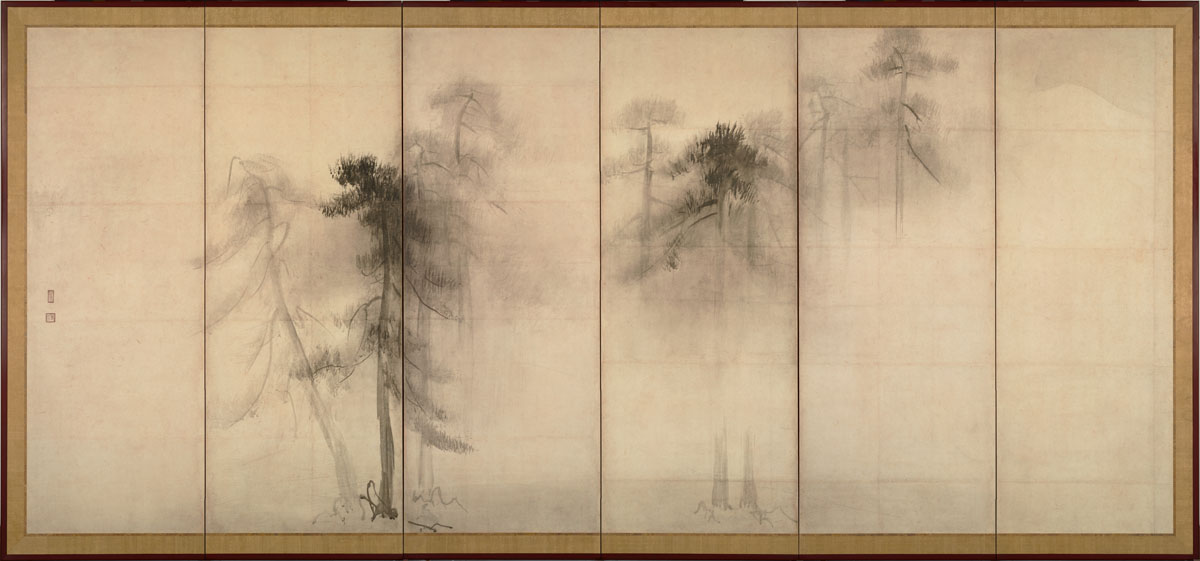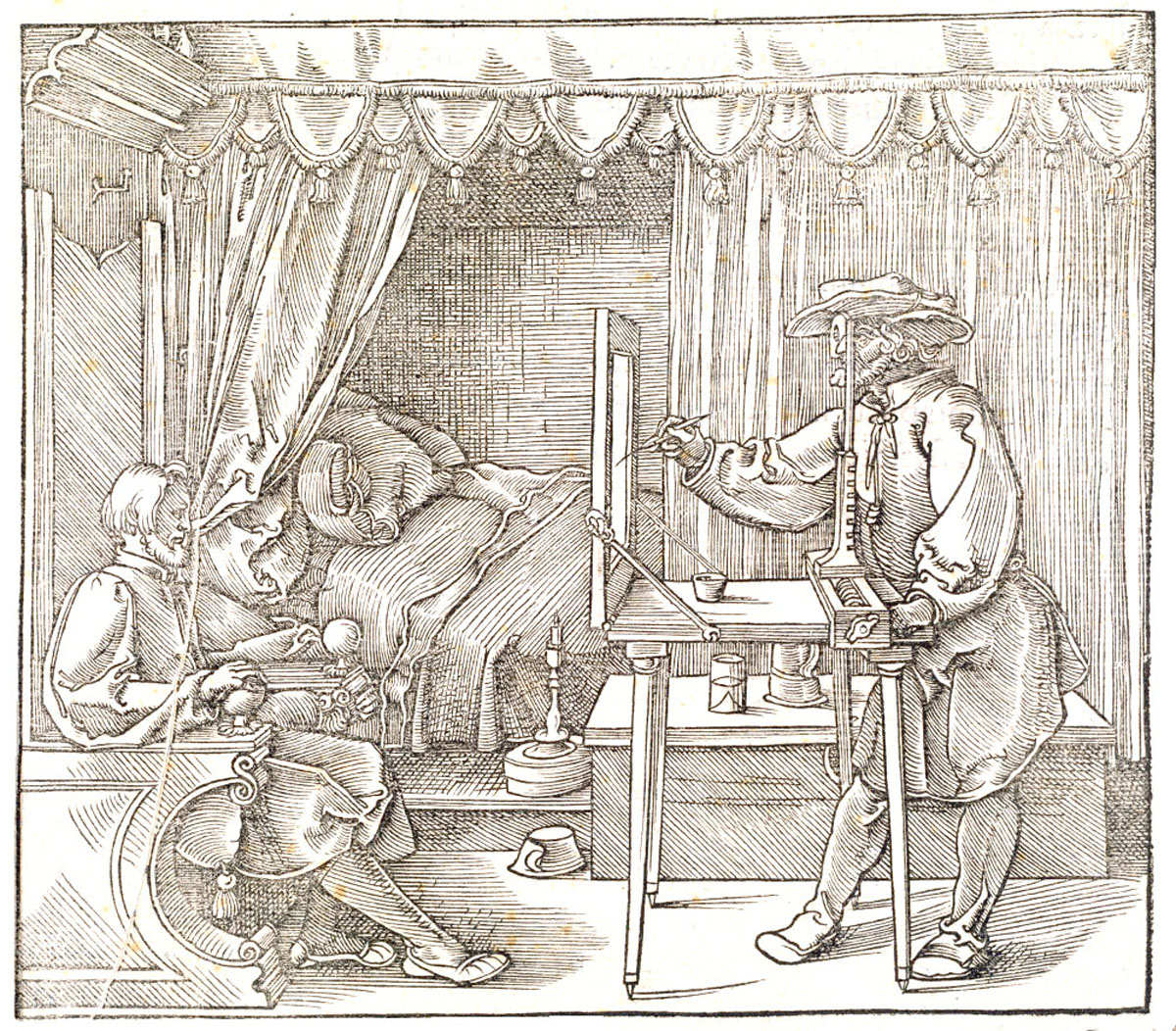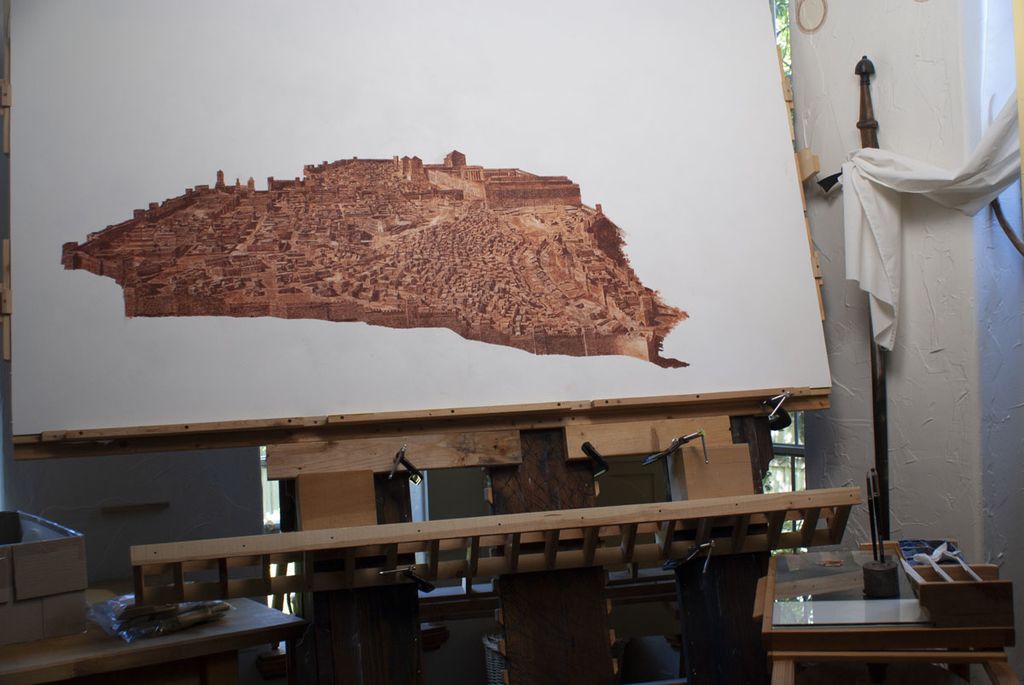Alberti's veil and the Tao of art
By Al R. Young
 |
| Pine Trees by Hasegawa Tōhaku (1539-1610) presented courtesy of wikimedia commons |
In the western tradition, the artist also studies his or her subject, but focuses primarily upon its shape or appearance, which, of course, involves the way the subject interacts with light and what happens to its shape, depending upon the vantage point of the viewer. The integrity of an articulation of an image upon a support, in the western tradition, focuses primarily upon shapes as opposed to the soul or essence of the subject. In the western tradition, the first consideration in creating a traditional artwork is getting the shapes right, with essence being more or less a bonus as work upon the image progresses. In terms of perspective, images were created for relatively small, individual panels or sheets of paper, to be viewed as a whole from a single vantage point.
Since the 15th century, perspective rendering in the western tradition has been so rigorous a paradigm and so pervasively embedded in cultures (i.e., expectations concerning traditional depictions of scenes of any kind) that for at least five centuries (and counting) artists have struggled to find ways of dealing with perspective rendering, so that upon satisfying its demands the artist can move on to express the nature or essence of the subject. This is not to say that perspective is bad, but merely to remark that dealing with it, in the day-to-day work of image creation, has occupied some of the best genius that western artists could devote to it. In fact, no small degree of the art revolution of the twentieth century can be viewed as attempts to break out of the aims and strictures associated with perspective.
In 1436, Leon Battista Alberti wrote De Pictura to "explain the art of painting" He declared that creating an image consisted of three activities: "circumscription, composition, and reception of light" and that "circumscription is the process of delineating the external outlines" (what we might call ghosting) the contours of the objects constituting an image. Alberti also declares that "no composition and no reception of light will be praised without the presence of circumscription."(composition being "how the visual plains of the object are fitted together" and reception being "the colours of surfaces" Furthermore, that because the integrity or quality of any image depends fundamentally upon the first of these three activities, "attention should be devoted to circumscription; and to do this well, I believe that nothing more convenient can be found than the veil, which among my friends I call the intersection, and whose usage I was the first to discover.
My interests as an artist arise from both the lack and the presence of nature in my life. Although born in the desert southwest of North America, I have never felt at home in deserts. I avoid glare because of sheer pain, and childhood asthma gave me an aversion to the climate and the dust. On the other hand, I thoroughly enjoyed everything about the desert from the horizon to the zenith, rejoiced at having a 360-degree view of the horizon, and owing to my natural aversion to everything I encountered in the built environment as well as the desert, I discovered my mental and emotional homeland to be in the leeward folds of the mountains where forests thrived in rainfall scraped from winds aloft. For these reasons, I am assuredly eastern in my assimilation of what I most delight to paint, which is, simply stated, what I found missing in the setting of my nativity. And I must be eastern in my skies because I lose myself more thoroughly there than anywhere. In other subjects, I am most certainly western. Nor do I think myself more of a hybrid than any other artist. I believe both traditions aim at the same ends, both paths to those ends are fraught with obstacles, and the inspiration that drives the work of art flows as best it can through the same kinds of topographies of influence that shape its course in either tradition. And I believe that expressing the essence or soul of the subject constitutes great art in either tradition.
 |
| Draughtsman Drawing a Portrait (1532) by Albrecht Dürer (1539-1610) presented courtesy of victoria and albert museum |
In creating Rending the Veil, Trailhead, and The Dawning of a Brighter Day I used the idea of Alberti's veil not so much to achieve a desired perspective as to cope with the sheer volume of detail to be rendered. This use of grids is not generally addressed in discussions about the genesis of the idea or its use. Perspective almost always dominates introductions to Albert's veil. Therefore, it is important to remark the distinction between the use of the veil or grid as it applies to perspective and as it applies to density of detail; otherwise the subject is far more complex than it need be, unless, of course, perspective is your focus. I already had the perspective I needed for these paintings. What I lacked was a way to work only on a manageable (or, more precisely, memorable) quantity of detail at any given time. Memorability is a ratio between the size of the cells in the grid and the maximum amount of detail in any given cell. And that ratio is unique to the artist and to the level of detail the artist hopes to achieve in the rendering.
There is another matter in all this that merits attention, but I do not address it here because doing so would constitute a digression from which we might forget what we were talking about to being with. That question is: At what point does art cease to be art because of too great a reliance upon technology? I address this recurring question constantly (in a world now focusing on artificial intelligence and widgetry for every convenience imaginable) by a personal decision about whether or not the artist's eye and hand are roughly as important in the creation of the image as they have always been in the machine-crazed onslaught of the western tradition. IF they are, I believe I am still within the bounds of tradition. If not, I need to acknowledge that the work is a mixture of media. In the case of the three paintings mentioned, the mark-making in the image was entirely freehand.
drawing freehand
I have done enough freehand drawing from life to be satisfied that I can do so. I have also spent a goodly number of years in which drawing was my primary artistic expression. But whenever it has come down to the production of highly crafted tonal drawings, similarly rendered lithographs, or oil paintings, I have chosen not to rely upon freehand drawing because doing so would have jeopardized complex, multi-stage artworks for no good reason (given the availability of other means for accomplishing that for which freehand drawing was the only recourse). My decision concerning when to rely on freehand drawing was always pragmatic. In a multi-stage, complex artwork, discovering a problem at any point "down the road" could result in unbearably costly personal, financial, and collaborative consequences (where deadlines were concerned).
Freehand drawing involves knowing where a mark starts and where it ends. For me, knowing where those two points are is a matter of longitude and latitude on the drawing surface. That is what I use the sides of the cell for; which is to say, I fix in my mind where the start-point is relative to the nearest corner of the cell (the vertical side and its companion horizontal side); then, I note where the end-point of the mark needs to be relative to a point similarly defined with reference to another corner. Finally, I note the arc or straightness of the mark that needs to be made. Once the mark is made, this process begins again and is repeated until the detail I want to represent is rendered. Of course, as marks accumulate in a cell, I do not always have to use the sides of the grid as reference. Then, when the cell is rendered, the work moves to an adjacent cell, and so on, until the imprimatura is finished.
There are variations to what I have described, depending upon the artist. For example, Instead of holding the data in memory, an artist might choose to transfer the start- and stop-points by means of calipers or marks on a straight edge or marks of the drawing surface. There are also techniques of mark-making that do not employ visual marks; instead, the start- and stop-points are locations on an arc of movement that consists of a unit of motion. The artist holds the points in the visual field, establishes the duration of motion by one or more practice-strokes in the air, then makes the mark as rehearsed. Typically, these sketch-lines provide arcs and intersections, which are used to complete the rendering.
digital projectors
Digital projectors are an excellent way of accommodating the kind of sketch-line approach to drawing described above. And inasmuch as the projector is presenting a two-dimensional version of a three-dimensional reality, the matter of perspective has already been taken of by the camera. Perhaps the major problem with having the artist's hand and tool between the support and the back-lit image, is the shadow cast by hand and tool The degree to which you can work around this circumstance is largely the degree to which a projector can serve your needs. However, one other factor that figures in the successful use of a projector is the granularity, density, or scale of the detail to be rendered. If the image to be articulated is crammed with detail AND you are creating a small image, a projector may prove impractical.
sizing the cells in a grid
The size of the cells in a grid must be proportioned to the amount of information an artist can hold in memory while going from referent image to rendered image for the purpose of making a mark. That proportion varies according to the density of the detail in the cell.
In a former life as a software engineer, in days when computers were being taught to see, I was introduced to studies that mapped movement of the human eye across images (like paintings) and tracked the saccadic movements of the eye. The plotter-like output of the equipment that tracked eye movement, showed that the human eye is drawn to sharply delimited boundaries between regions of high contrast. The eye is not only drawn to such boundaries, but keeps returning to them, interspersed with movements over regions of low contrast, presumably to rest there. The more boundaries in an image or in a region of an image, the greater its data density, not to be confused with what data density has since come to mean.
My use of a grid has nothing to do with perspective, but everything to do with data density. For example, Rending the Veil and The Dawning of a Brighter Day have regions of great data density—the cityscape in the former and the blossoming fruit tree in the latter, Accordingly I used a grid in both regions, but nowhere else in the paintings. In trailhead, however, crammed with botanical material from top to bottom, I used a grid for the whole image. Initially, I thought Trailhead could be done with larger cells, but soon discovered that I needed to use the same cell size that was using for Rending the Veil.
Another reason for using a grid is that it greatly simplifies keeping track of where one is in relation to the whole; in terms of both image and project.
Detail about Rending the Veil
The grid for Rending the Veil consisted of 324 cells, each measuring 1 7/8 in. x 1 5/8 in., my optimum cell size for the data density of both Rending the Veil and Trailhead.
In my project journal for Jerusalem, I made the following entry for 2018 June 22, the day I finished the cityscape-portion of the underpainting:
Cells painted today - 10
Running cell tally up to 2018 June 22 - 324
Running cell-session tally - 93
Running cell tally for June - 88
Running cell tally is the total number of cells painted since I started the underpainting.
Running cell-session tally is the number of painting sessions devoted to painting grid-cells, which was, of course, the only thing I had yet painted in the underpainting.
Running cell tally for June is simply the tally for the current month, followed by earlier monthly tallies.
This painting project was so tedious and stretched out across enough years that during the early stages of the work I needed milestones in order to feel like I was actually getting somewhere. This kind of record keeping provided them. On 2018 June 22, I also took a look back just to enhance the enjoyment of what the June 22nd milestone (of completing the underpainting) meant, in terms of labor expended:
2018 June - 88
2018 May - 29
2018 April - 27
2018 March - 29
2016 December - 15
2016 November - 1
2016 May - 1
2016 April - 6
2016 March - 17
2016 February - 15
2016 January - 20
2015 September - 6
2015 July - 13
2015 June - 30
2015 May - 23
 |
| The completed underpainting for the cityscape in Rending the Veil. |
Detail about Trailhead
On 2015 May 23, I noted the following in the project journal for the painting:
Cells painted today - 10
Running cell tally - 213
Running cell-session tally - 35
Tags: 3.00.0306.010, 3.00.0307.010, 2021, Project commentaries, Tips and techniques, Tools supplies and operations
Browse articles by year: 2026 . 2025 . 2024 . 2023 . 2022 . 2021 . 2020 . 2019 . 2018 . 2017 . 2016 . 2015 . 2014 . 2013 . 2012 . 2011 . 2010 . 2009 . 2008 . 2007 . 2006 . 2005 . 2004 . 2003 . 2002 . 2001 . 2000 . 1999 . 1998 . 1997 . 1996
Browse articles by topic: Art lessons . BenHaven Archives . Blank art diaries . Fine art photography . Framing . Illustration . Inspiration and creativity . Isles of Rune . Limited Editions Collection . My Fathers Captivity . News . Novellas . Oil paintings and prints . Operations announcements . Orders and shipping . Overview . Portfolios . The Papers of Seymore Wainscott . Project commentaries . Recipes by Nancy Young . Recommended reading . Recommended viewing . Temple artworks . The Storybook Home Journal . Tips and techniques . Tools supplies and operations
Browse articles by topic: Art lessons . BenHaven Archives . Blank art diaries . Fine art photography . Framing . Illustration . Inspiration and creativity . Isles of Rune . Limited Editions Collection . My Fathers Captivity . News . Novellas . Oil paintings and prints . Operations announcements . Orders and shipping . Overview . Portfolios . The Papers of Seymore Wainscott . Project commentaries . Recipes by Nancy Young . Recommended reading . Recommended viewing . Temple artworks . The Storybook Home Journal . Tips and techniques . Tools supplies and operations